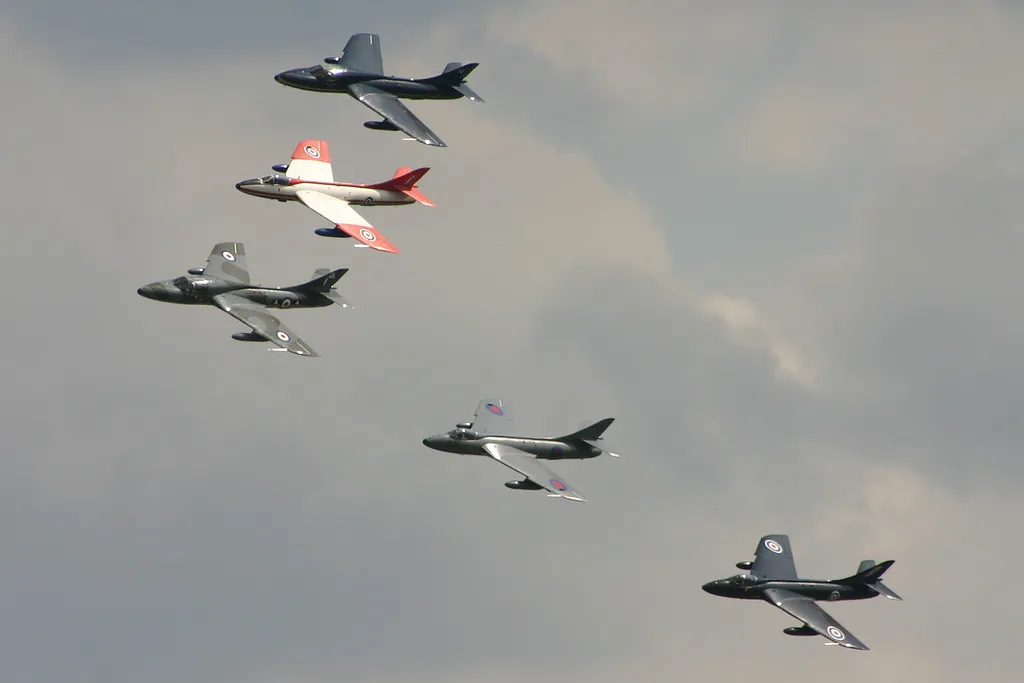Fate Is the Hunter
A Hawker Hunter crash in England calls airshow routines into question, but it shouldn’t.
/https://tf-cmsv2-smithsonianmag-media.s3.amazonaws.com/filer/e6/ef/e6ef0495-9c74-4f99-b734-fdf6051f176a/12863561684_514c61757e_b.jpg)
The recent crash of a Hawker Hunter T7 at the Shoreham Air Show in England [warning: the footage is graphic], which killed 11 people, resulted in the U.K.’s Civil Aviation Authority restricting flight routines by vintage jets. The Shoreham crash comes less than a month after the crash of a Folland Gnat in North West England that killed pilot Kevin Whyman.
The Hunter pilot, Andy Hill, was an experienced former RAF and active British Airways pilot. He survived the crash but remains in the hospital in critical condition. Though no official reports will be released for some time, footage from show-goers appears to show that Hill entered a loop at too low an altitude—in which case, despite his clear efforts to pull up, a crash was virtually inevitable. Unusually warm weather, which degrades aircraft performance, may have played a part.
All flyable Hawker Hunters in the U.K. (there are 15 registered) are grounded until further notice, and airshow routines involving vintage jets are restricted to flybys instead of aerobatics. The CAA says it will conduct a “full review of civil air display safety.”
Pilots plan and practice very carefully to minimize risk, but any high-performance flying strains both pilot and airplane. Doug Rozendaal, a veteran U.S.-based airshow pilot, says, “When you plan your routine you’re looking for where the outs are, what exit points you have, what margin you have if there is a pilot error or mechanical malfunction. But aviation’s a cruel business…. Step one is to acknowledge the risk. And any type of motor sport—and quite frankly many other sports—has risk associated with it.”

The Hunter that crashed at Shoreham was a 1959, two-seat T7 model built for the RAF, which had logged about 6,000 flight hours. Nearly 2,000 Hunters were built, starting with the 1950 prototype, called P.1067. The type had a long military career with more than a dozen air forces worldwide, some of which kept them flying until the 1990s. Several countries, notably the U.K. and Switzerland, have used the aircraft in airshow displays. Several companies in the U.S. and Europe keep small fleets of Hunters active to this day, to serve as realistic moving targets for military exercises.
The U.K.-based Hawker Hunters are mostly former RAF or Royal Navy aircraft, and many are in private hands. British aircraft of the early Cold War era are popular at airshows (one notable old giant from that era, an Avro Vulcan bomber, has been making its last rounds before permanent grounding); at the time the British aerospace industry was at its high point.
Fate is the Hunter, Ernest K. Gann’s classic memoir of an earlier era of flying, is a good reminder of the inherent dangers of aviation, which most casual airline passengers today have largely forgotten. One memorable passage near the end of the book recounts one of Gann’s DC-4 flights, when he noticed, but then dismissed from his mind, an insistent vibration, only to learn later that he had narrowly avoided a crash due to aerodynamic unporting, an exceedingly rare problem that under certain circumstances would have put his airplane into a virtually unrecoverable dive. Most pilots seem to have at least one similar story about a minor error on someone’s part that nearly proves fatal. And for airshow pilots during a performance, the safety margins are very, very small.
Airshows have always drawn fascinated crowds, but often overshadowed is a deeper purpose. Many pilots, particularly those who fly restored military aircraft, see airshow flying not simply as entertainment, but as a tribute to the sacrifices of pilots who came before them. “The reason why we fly warbirds is to employ the airplane as a tool to tell a story,” says Rozendaal. “When it’s done correctly we’re trying to inspire young people to reach for their aspirations, and to understand that these airplanes and the men who flew them are a major contributor to the reason why we live free. Very few things that we do evoke freedom more than flying, and aerobatic flying is the epitome of that art form.”